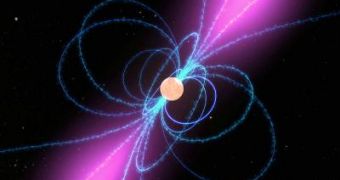The Fermi telescope from NASA has managed to depict from the myriads of celestial bodies the only one that emits its pulses in gamma-ray beams alone. It is about 10.000 years old and it sends its light towards Earth at a rate of 3 times per second or, more precisely, once every 316.86 milliseconds. The amount of energy it emanates is about 1.000 times higher than that of our Sun.
A pulsar is defined as the fast-spinning crushed core of a star that exploded in a supernova (neutron star). Most of them emit radio wavelength pulses, while there are many the energy of which is emitted in X-ray or even visible light, but this is the first one discovered to be emitting only gamma-ray pulses. It is located approximately 4.600 light years away, in the CTA1 dying supernova from the Cepheus constellation.
Since a supernova explosion is not symmetrical, the pulsar is not located in the middle of it, but, according to the researchers' calculations based on the age of the supernova and the distance from its center to the pulsar, it has been concluded that the neutron star is rather racing through space at a regular speed (for such cases) of about 1 million miles (1.6 million km) per hour. Also, the one-per-minute gamma-ray spotted to come from CTA1 helps determine the behavior, rotation rate and slowing rate of the pulsar.
"This is the first example of a new class of pulsars that will give us fundamental insights into how these collapsed stars work," stated Peter Michelson from Stanford University, Fermi's Large Area Telescope main investigator. Alice Harding from NASA's Goddard Space Flight Center in Greenbelt, Maryland added: "We think the region that emits the pulsed gamma rays is broader than that responsible for pulses of lower-energy radiation. The radio beam probably never swings toward Earth, so we never see it. But the wider gamma-ray beam does sweep our way."

 14 DAY TRIAL //
14 DAY TRIAL //